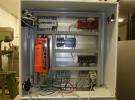I have just purchased a T7-Pro for using thermocouples. I have 5 thermocouples on a CB37 and 2 thermocouples on the T7 itself. All of them are connected with a 10kOhm resistor between the negative channel and ground. I have read through the notes about cold junction and how it is assumed on the CB37 that it is at room temperature so you use that as your CJC for thermocouples on that terminal board. I am getting about 2°C difference between the thermocouples on the T7 versus a lower temperature on the CB37 using the ambient temperature as the CJC.
I guess I am having a hard time understanding why there is a difference and how people should compensate for that using the Mux80 and more CB37's down the line. I also did a cold bath test with the thermocouples and got greater than 1°C difference, much closer. I am trying to test the reliability of this thermocouple method before I build a data acquisition test setup.
Thanks.



.png%3Fitok=PHGBxf6M)


.jpg%3Fitok=B1YcuDFK)
.png%3Fitok=Ybt-OlgU)
If using the internal temp sensor for CJC, you would typically use TEMPERATURE_AIR_K with the CB37 and TEMPERATURE_DEVICE_K with the T7 terminals.
https://labjack.com/support/datasheets/t-series/internal-temp-sensor
Thermocouples are generally only accurate to a couple degrees, and there are lots of other sources of error besides the thermocouple itself, but if you are seeing a systemic 2 deg error between multiple differentially connected thermocouples on CB37 terminals and multiple differentially connected thermocouples on T7 terminals, CJC error is the most likely culprit, so for this discussion lets assume that is your only error. With that assumption, we know that the relative error of TEMPERATURE_AIR_K versus TEMPERATURE_DEVICE_K is 2 degrees, so for example TEMPERATURE_DEVICE_K could be reading 0.5 degrees low and TEMPERATURE_AIR_K could be reading 2.5 degrees low. The device temperature here is well within spec. The air temperature is an estimate based on typical temperature rise of the T7, so is not specified for accuracy.
The first improvement is to only connect to CB37s. All CB37s should be at the same temperature ... air temp. This means that all thermocouples have the same CJ temperature, and you will use the same CJ temperature for all, so you will have the same error for all. If relative accuracy (one t/c versus another) is the most important thing in your experiment this is all you need to do, but if absolute accuracy is important then do the next step.
The next improvement is to use a sensor (e.g. LM34CAZ) to measure air temperature. This will improve the absolute accuracy of your CJ temperature measurement compared to using the estimated TEMPERATURE_AIR_K value.